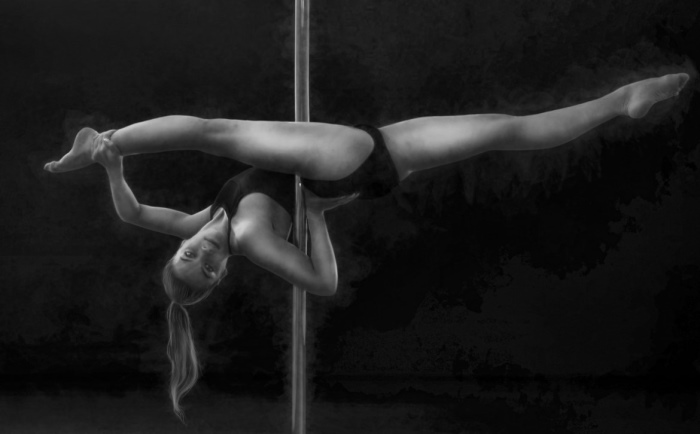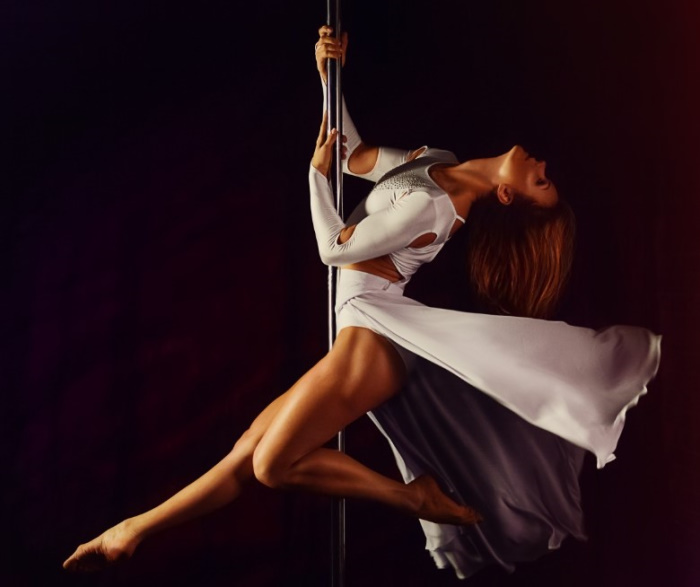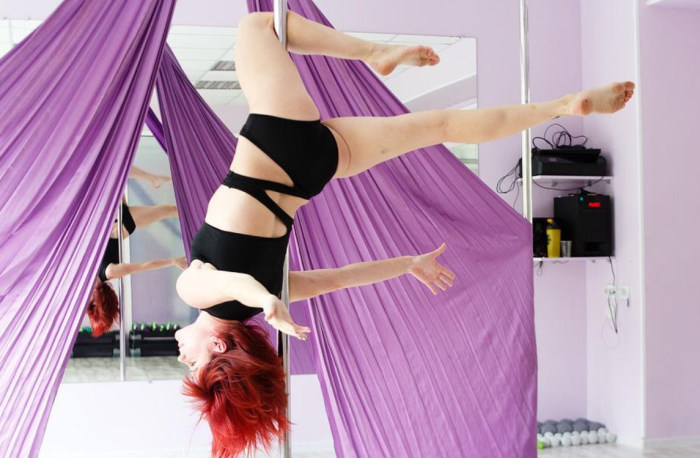If you’ve already mastered the pole dance moves for beginners, then you can challenge yourself with higher-level postures.
Here is a list of intermediate and advanced pole dance moves along with some tips when performing that you can try practicing.
Table of Contents
14 Popular Intermediate Pole Dance Moves
1. Anastasia Frog
For a show-ending move or photo shoot, the graceful poise of the Anastasia Frog makes it an attractive option for dancers.
Compared to other intermediate-level pole dance moves, this move is quite easy to get into.
If you’re going to practice, we highly recommend doing it on a static pole. It’s possible to do it on a spin pole, but that would require advanced techniques.
2. Assisted Pencil Spin

Practicing on a spin pole? Try the Assisted Pencil Spin.
Gripping onto the pole with either a baseball or an anchor grip, you have to activate all of your core and shoulder muscles in order to keep the body vertical.
The move is considered “assisted” because your inside foot aids with the momentum. An unassisted Pencil Spin is when you deadlift your body onto the pole and into a spin.
3. Ballerina Spin
True to its name, the Ballerina Spin is a very elegant and graceful move.
It can showcase your body and fluidity, drawing attention to the beauty of the dance – over the natural sexiness.
One leg is wrapped around the pole, the other leg is extended. You can contort into different shapes on the pole once you get into position.
The Ballerina Spin is easiest to do on a spin pole, but it can also be done on a static pole.
4. Basic Invert
The Basic Invert – though it’s called “basic” – is actually an intermediate-level move. Most pole dancers will consider the day they pull off this move to be a milestone in their career or hobby.
Mastering this trick means gaining a ticket to practicing other, more advanced moves and techniques.
It requires a lot of core strength from the dancer, as well as confidence when going upside down.
Practicing the Basic Invert is an entire journey that first has to start with doing a pre-invert prep session. Prepping before you go inverted will make the performance safer.
5. Carousel Spin
With the Carousel Spin, you face the pole, grip it with both hands, then push your body into a spin. The knees then come up and the arms extend to hold the body away from the pole.
It is a beautiful move that can be done on both static and spin poles.
However, because your arms are going to be bearing your entire body weight, it’s important to practice the Push-Pull method and train your muscles.
6. Corkscrew Spin
To do the Corkscrew Spin, you need to know your way around an anchor grip. The spin leverages this grip to keep your body off the ground and separated from the pole.
As you’re spinning, you can bend or straighten your leg to give your performance a personal flair.
This spin-type move is often done on a spin pole in order to get a smoother motion.
7. Cross-Knee Layback
Like the Basic Invert, many dancers consider being able to pull off the Cross-Knee Layback a milestone.
This is because although it is classified as an intermediate move, it’s pretty tricky in practice and borderline advanced for some people.
The Cross-Knee Layback demands a lot of core strength as well as familiarity with the technical side of the move.
Because you’re basically going inverted, go through the move slowly and step by step when you first start out.
8. Forearm Grip Shelf
This is an important form to master as many advanced moves (often inverted) require you to master it.
The Forearm Grip Shelf can give your body a fulcrum similar to an anchor grip in a climbing move.
9. Hello Boys
This is one of the moves to add to a routine when you want to add a bit of pop to your routine.
You can vary the speed of the motion to achieve different effects: quick and it will give your performance a burst of speed and energy, slow and you’ll exude sensuality.
In order to do the Hello Boys well, you must be comfortable with doing the Pole Sits and a Wrist Sit.
10. Jamilla
Like many other poses in the intermediate list, the Jamilla is the prerequisite move that you need to learn if you want to try other tricks. It’s the gateway to many transitions and inverted moves.
The key advantage to the Jamilla is that you don’t have to wrap your legs around the pole. It makes transitioning to certain tricks easier, simpler, and quicker.
11. Jasmine
The Jasmine can serve as your gateway to sideways spins and flips. It can also serve as your transition into many inverted moves in place of the Basic Invert.
All you have to do is to change the positioning of your hands on the pole.
There is an advanced variant of the Jasmine. It involves letting go of the pole with your top hand and extending it way past your head while pushing your chest outward.
The intermediate-level version is, of course, simpler and easier to practice.
12. Scissor Sit
The Scissor Sit is executed by first getting into a Basic Pole Sit. Then, your legs open up into an arrow shape (similar to the character “>”).
It’s a great way to introduce a new body shape to your routine.
13. Tabletop
The Tabletop position can move your body parallel to the ground while seated solidly on the pole.
As a pose, it can draw your audience’s attention to your strength and looks quite good in photoshoots.
And as a transition, the Tabletop can be used to move into a great many other intermediate and advanced-level moves.
14. Tabletop Tuck
Similar to the standard Tabletop move, the Tabletop Tuck can be used as a transition to other tricks.
But, if done well enough, the Tuck can create a beautiful illusion in your performance, making it look like you’re hanging on the pole with just one hand.
The secret? This trick is performed with one arm behind your back.
But it’s because of this exact requirement that the Tuck is difficult to get right. You need strength and flexibility in your shoulder area to both get into position and hold your body weight in the air.
Advanced Pole Dancing Moves
By the time you get to advanced level pole dancing, it’s all about being creative and thinking outside of the box.
So, there aren’t many “textbook moves” to learn. Nevertheless, mastering a few foundational skills can help you with creating new, exotic moves for your routine.
1. Armpit Hold
The Armpit Hold is considered advanced because it’s uncomfortable to do. Chafing and pinching your armpit – a naturally sensitive area – against the pole does not feel nice.
However, if pulled off successfully, it allows your body to form gorgeous shapes and act as an entrance to other moves, like the Teddy or the Chopstick Split.
2. Football Grip
The Football Grip is a popular grip that’s used in many inverted moves.
In this move, the elbows are in close contact with the pole and help bring your body closer to the pole.
When locked tight, you can perform moves that utilize your lower body with more points of contact (at least two).
3. Funky Grip
If you want to bewilder your audience and keep them on their toes, try the Funky Grip. This grip gained this name (and many other names, like the “Goofy Grip” or “Funny Grip”) because of its unique shape.
The audience – even experts in the crowd – would find it difficult to predict what you would do next. This is why the Funky Grip is very popular in pole dancing competitions.
It’s a bit challenging to pull off, but the effect is well worth the time and effort into practicing.
4. Remi Hold
The Remi Hold allows your body (particularly, your legs) to form a very intricate pattern on the pole. It’s similar to a pretzel or a knot.
The advantage of this pole hold is that it gives you a very solid base to perform a wide number of upright and inverted tricks.
The downside is that most people will find it to be a rather uncomfortable hold, especially when performed on smaller poles.
5. Reverse Foot Mount
Also known as the Foot Hook, the Reverse Foot Mount requires you to bring your foot around the pole and flex your foot and toes.
The point is to provide a counterbalance when performing tricks like the Starfish.
6. Tabletop Hold
Even for advanced-level dancers, the Tabletop Hold can be a challenge. The Tabletop Hold takes its name from the Tabletop move (you can read about it in the intermediate-level section above).
The top hand holds the pole above the head, and another arm behind your back holds onto the pole.
It’s not an easy position to get into, but with a bit of practice, you can get into it without feeling too uncomfortable.
Tips For Performing Advanced Tricks
Find A Spotter
A spotter can help you avoid injuries and correct you when you’re doing something wrong (especially at advanced levels when it’s easy to get a technique wrong).
Pay Attention To Your Skin-to-Pole Grip Strength
Many moves will require you to release your hands on the pole. Pay close attention to your skin-to-pole grip strength. Until you’re very certain that your grip is secured, don’t let go!
Apply Grip Powder
Grip powder can help you maintain a better grip on the pole. However, don’t grip too hard, or else your skin will peel.
Expect Small Injuries
Like any other sport, small injuries are to be expected in pole dancing. Practicing or performing on a pole for long periods can lead to calluses, bruises, or blisters. Don’t be too surprised when you get them.
That doesn’t mean you should ignore serious injuries like achy or sprained wrists, pulled shoulders, or the like, though. These injuries are abnormal and often a result of bad technique.
Your Skin Will Adapt
At first, your skin will be soft, so it can get very painful after a practice session from all the chafing. The more you practice and perform, the tougher your skin will be. Previously irritating or painful moves will affect you less.
All the more reason to practice regularly!
Final Words
This is not an all-inclusive list of pole dance moves. There are many more moves and poses to learn. Surely, the more you practice, the better your skill is.
Enjoy your time and share with us if you invent a new interesting move!



These might be advanced for most women but not overall. Overall, these are intermediate at best. What are the most advanced moves ever done by anyone? I’m talking about crazy pro moves like climbing the pole by kipping upwards in a handstand position. Thanks.